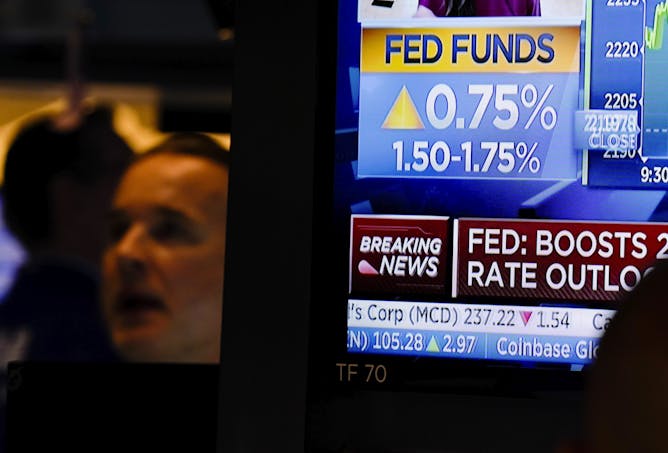|
The Federal Reserve is trying to slam the breaks on the U.S. economy as it plays catch-up in its belated fight against spiking inflation. Yesterday’s 0.75 percentage point rate interest rate hike – the biggest since 1994 – is just the start, with an equally supersized increase possible in July. By the end of the year, the Fed now expects its target short-term interest rate, which benchmarks the borrowing costs on pretty much everything, to reach 3.4% – double what it is now.
Could that cause the U.S. economy to fall into recession? The odds of one next year are “close to a coin flip,” writes Brian Blank, who studies how businesses adapt and handle economic downturns. The Mississippi State University finance scholar explains how the Fed is trying to nail a “soft landing” for the economy, the stakes if it gets it wrong and what it all means for consumers.
Also today:
|

Wall Street is following Fed rate hike news with rapt attention.
AP Photo/Seth Wenig
D. Brian Blank, Mississippi State University
The Fed raised interest rates the most in nearly three decades to fight stubborn inflation. A finance expert explains what’s happening, the risks and what it means for consumers.
|
Arts + Culture
|
-
Valerie M. Fridland, University of Nevada, Reno
A linguist explores the origin of the word ‘father’ – and why derivatives are common in languages across the globe.
|
|
Science + Technology
|
-
Hayder Radha, Michigan State University
An autonomous vehicle expert explains how Tesla’s Autopilot works, what prompted US authorities to investigate the system and what changes might be in store for the company.
-
Mary Lynn Reed, Rochester Institute of Technology
A mathematician explains how language can keep your online accounts safe and pinpoint your location on the planet.
|
|
Health + Medicine
|
-
Denise Bodman, Arizona State University; Bethany Bustamante Van Vleet, Arizona State University
Being a parent can be tricky, and many turn to parenting guides for help in figuring out what to do. Two human development scholars have tips for picking a book that will be useful for you.
|
|
Environment + Energy
|
-
Carlos G. García-Quijano, University of Rhode Island; Hilda Lloréns, University of Rhode Island
Puerto Rico’s tourism industry is booming as nations lift COVID-19 travel restrictions, but development is displacing people who have lived along its coastlines for years.
|
|
Education
|
-
Jonathan Alexander, University of California, Irvine
A scholar of queer literature takes a closer look at five books that are pushing the envelope on society’s understanding of LGBTQ life.
-
Royette T. Dubar, Wesleyan University
With online use ever-increasing, so is the rise of ghosting – when friends decide to disappear into the social ether.
|
|